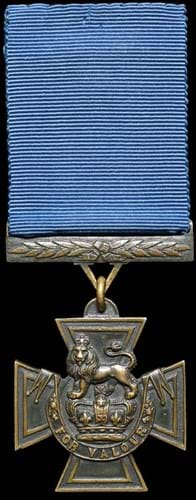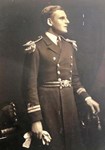Not just the £360,000 hammer price, which was not to be sniffed at, but the fact that the underbidder was taking part in the auction online while on holiday with his family in the south of Spain at the time.
Also, the tally of three unsold lots out of 316 across the whole Orders, Decorations & Medals auction on July 21 – and the sale just a day earlier of a VC for £280,000 at Morton & Eden.
Such results reinforce a general feeling of well-being across the market for a wide range of price levels, particularly at the specialist London big-hitters, as the sector emerges from pandemic-hit years in a remarkably strong position.

Drummer W Ritchie of the Seaforth Highlanders won his Victoria Cross on the first day of the Somme as the ‘Bugler of Beaumont Hamel’ when, under a hail of machine gun and bomb attacks, he mounted the parapet of an enemy trench and continually sounded the ‘Charge’ on his bugle to rally and encourage his comrades. By the end of the war he had been wounded on five occasions and also added the Croix de Guerre to his laurels. Estimated at £150,000-200,000, his VC group made a hammer price of £360,000 at Spink on July 21, selling to an agent in the room bidding on behalf of a private collector. It had been sold at Sotheby’s and bought by Spink in 1970, then sold at Christie’s in 1978. Marcus Budgen of Spink said five bidders participated, “much like the VC to Squadron Leader Scarf we sold in April for £550,000 hammer” (see ATG No 2541). Of the 18 VCs won by the Seaforth Highlanders and its predecessor units, Ritchie’s is the only one not in a museum or the Lord Ashcroft Collection. It is the only one awarded for July 1, 1916, out of seven Seaforth Highlander Great War VCs. Seven of the nine VCs awarded in total for the first day of the Somme are known to reside in museums.
Current trends
Marcus Budgen, Spink head of medals since 2018, was certainly upbeat about the current trends as he talked to ATG about the state of play (and acknowledged the similar success enjoyed by fellow firms such as Noonans and Morton & Eden in particular).
While the challenges of Covid restrictions were considerable, medal auctions have weathered the storm particularly well (not least because they are easier to move around and store than a 6ft long Welsh dresser).
“Since Covid started we have not had less than 95% sold and often it’s been even closer to 100% – in fact we had a couple of sell-outs in that period”, said Budgen.
The market has experienced some interesting shifts, however.
“The big trend is to do with dealers: very little material has been going to dealers via auction”, added Budgen. “In excess of 75% has been going to collectors. That’s not to say that dealers are not doing very well in the current market. But even five years ago probably 50-60% of lots were going to collectors, around 40% to dealers.”
For the medals market (and many others) Covid restrictions meant would-be bidders had a chance to do their own research. “With more time on their hands to search online and spot things themselves people have been more independent perhaps and less likely to buy only from dealers. If something is in the sale that they want they can check for themselves.”
Story tellers
That internet opportunity has inspired not only an influx of fresh bidders but a shift in the profile of medals collectors as well at Spink.
Budgen said: “We have registered hundreds of new bidders – 50-80 for every sale since Covid began, so about 300-500 new people in that time. Many have become regular buyers.
“There have been a lot of new faces appearing but it is a myth that new collectors have to be young. Many are heading towards retirement and find they have more time on their hands; time to really learn about their subject. Before, they maybe couldn’t afford to collect but now they come to a point where, for example, their children have gone through university and many costs are gone.
“The new collectors are more interested in stories behind the medals, with much more opportunity to research online. In the old days you had a ‘type’ of collector, maybe ex-military, buying as many medals for a campaign, battle or regiment.
“Many collectors now are more interested in stories and events, famous actions such as the first day of the Somme or Rorke’s Drift. It is a much more ‘professional’ collecting base.
“Now we are seeing second or third generation collectors who want to know who actually served beside their grandfather and that person’s background.”
People are also more esoteric in their medal collecting, added Budgen. There are shared interests, crossover collecting, so it might be searching for medals of “someone who was a famous yachtsman, for example, or went to the same school.
“The social history angle is never-ending with sites such as ancestry.co.uk available. Collectors did not have that ability to do the individual research online before.”
Budgen pointed out that it is a different market to coin collecting where a piece will have “a time, a history to it and maybe a beautiful design, but medals have all of that plus the personal story. That’s what it is all about.
“The story of the man or woman behind the medal drives the price. Part of that is our printed catalogues, which are not just for the sale but also become historical reference works. Every one of our room sales will still have a printed catalogue.”
Spink’s online bidding platform has increasingly come into its own, Budgen said, and become a good way to serve not just the bottom to middle end of the market but also the higher end.

The Victoria Cross sold for £280,000 (£336,000 including premium) against an estimate of £150,000-200,000 by Morton & Eden on July 20 was actually awarded to a civilian volunteer attached to the Indian Naval Brigade in the Indian Mutiny. The last of five VCs awarded to civilians, it was earned by the improbably named George Bell Chicken on September 27, 1858, when he killed five rebels before he was severely wounded and then rescued. However, he died at sea just two years later while in command of the schooner Emily, lost with all hands during a squall in the Bay of Bengal. Strangely, this was one of two official VCs made for Chicken. The first was lost en route or possibly within India at the time of his death. This M&E medal has been confirmed as the second example which was officially and posthumously delivered to his father George Sr in Shadwell, east London. The first medal, official but unawarded, was later located and even ended up being sold by M&E back for £48,000 in 2006 and is now in the Lord Ashcroft Collection.
Passionate collectors
At the top end of the market, Budgen noted “the days of the £100,000 VC are long gone. The top 5% end of the market, around £50,000-1m, is incredibly healthy and it’s not investors but genuinely passionate collectors.”
The latest prices – see caption stories for more details – follow the record for a British Army VC of £420,000 at Dix Noonan Webb (now Noonans) in June last year and the RAF VC record of £550,000 set by Spink in April this year.
















